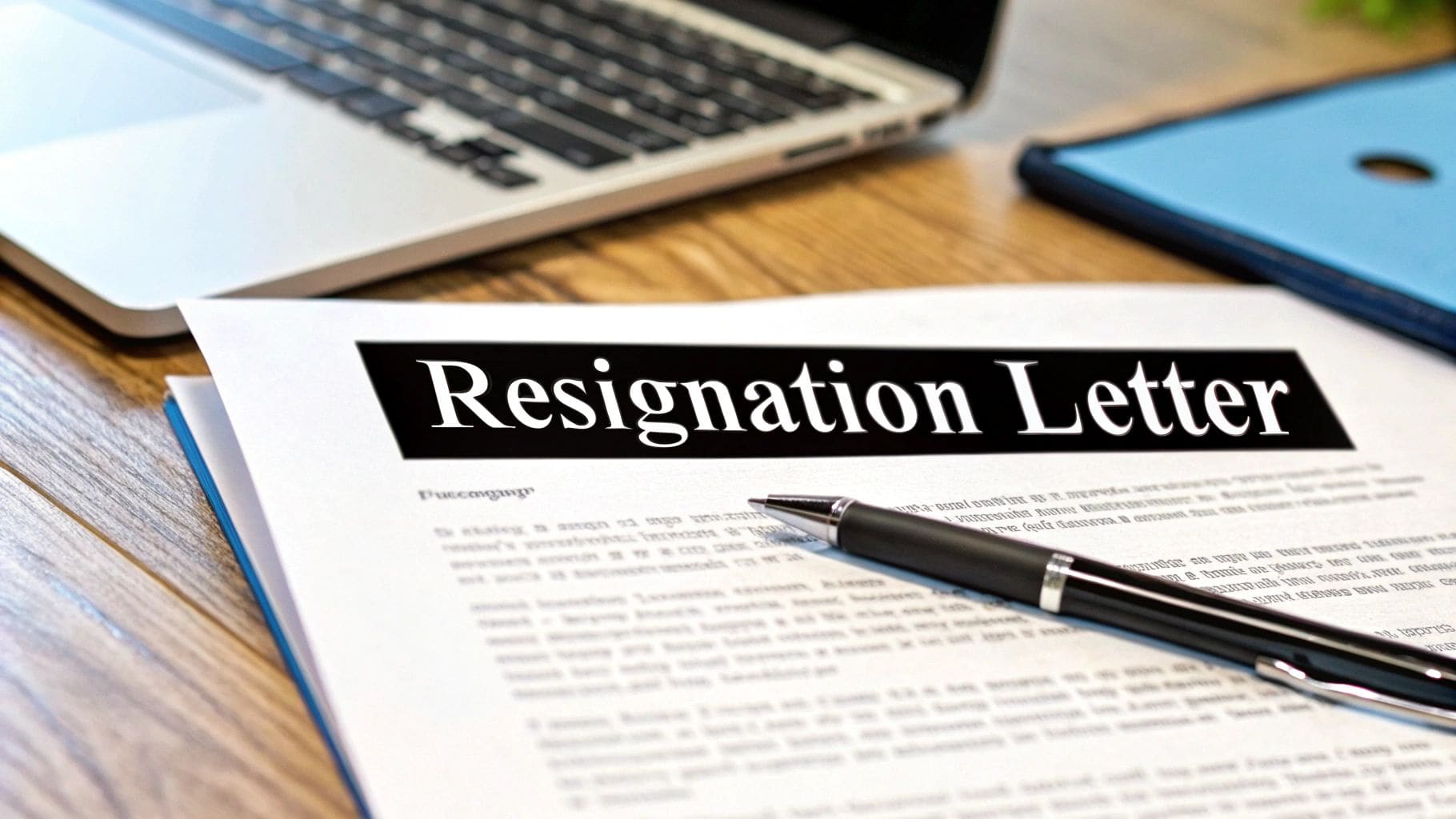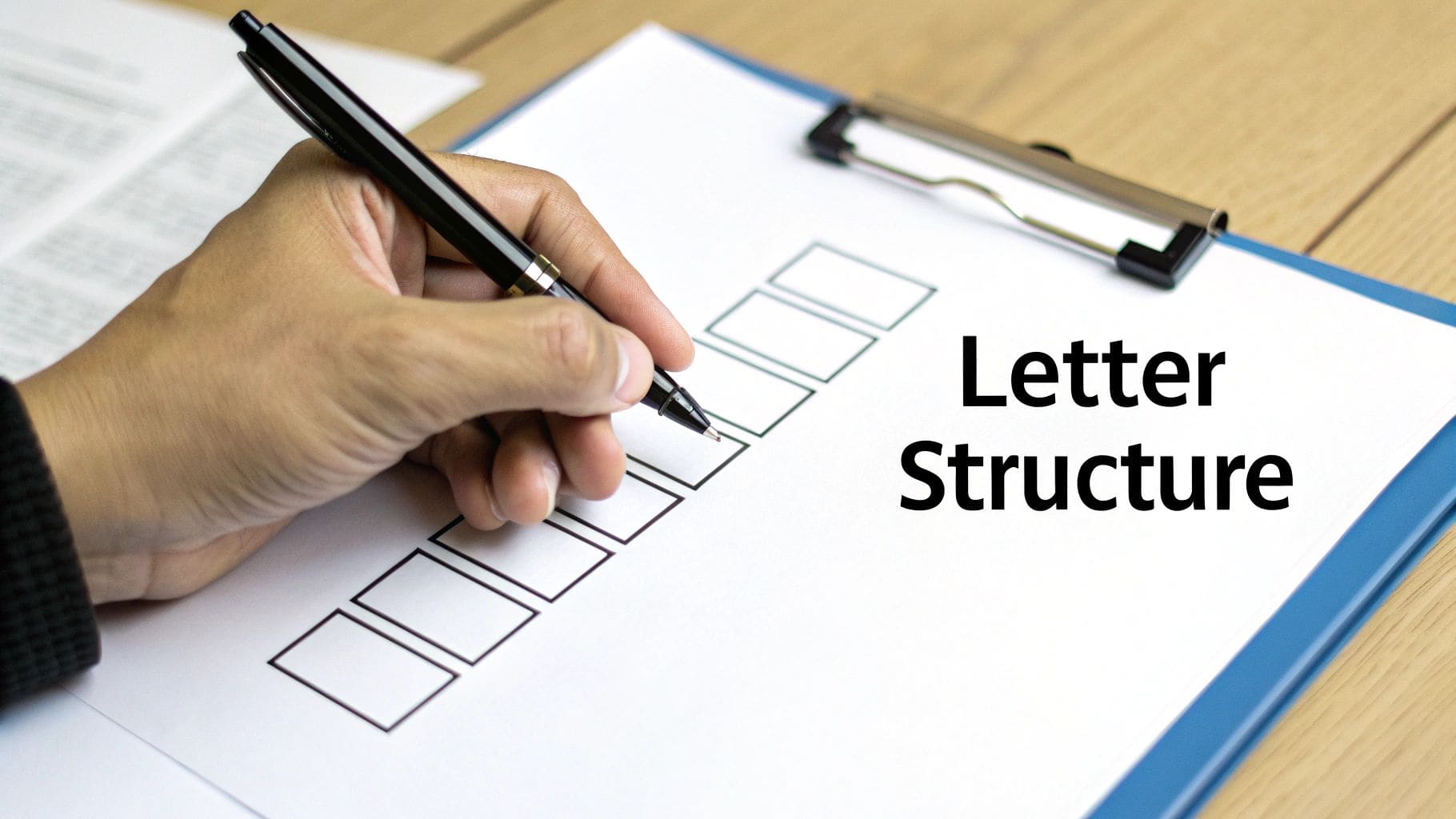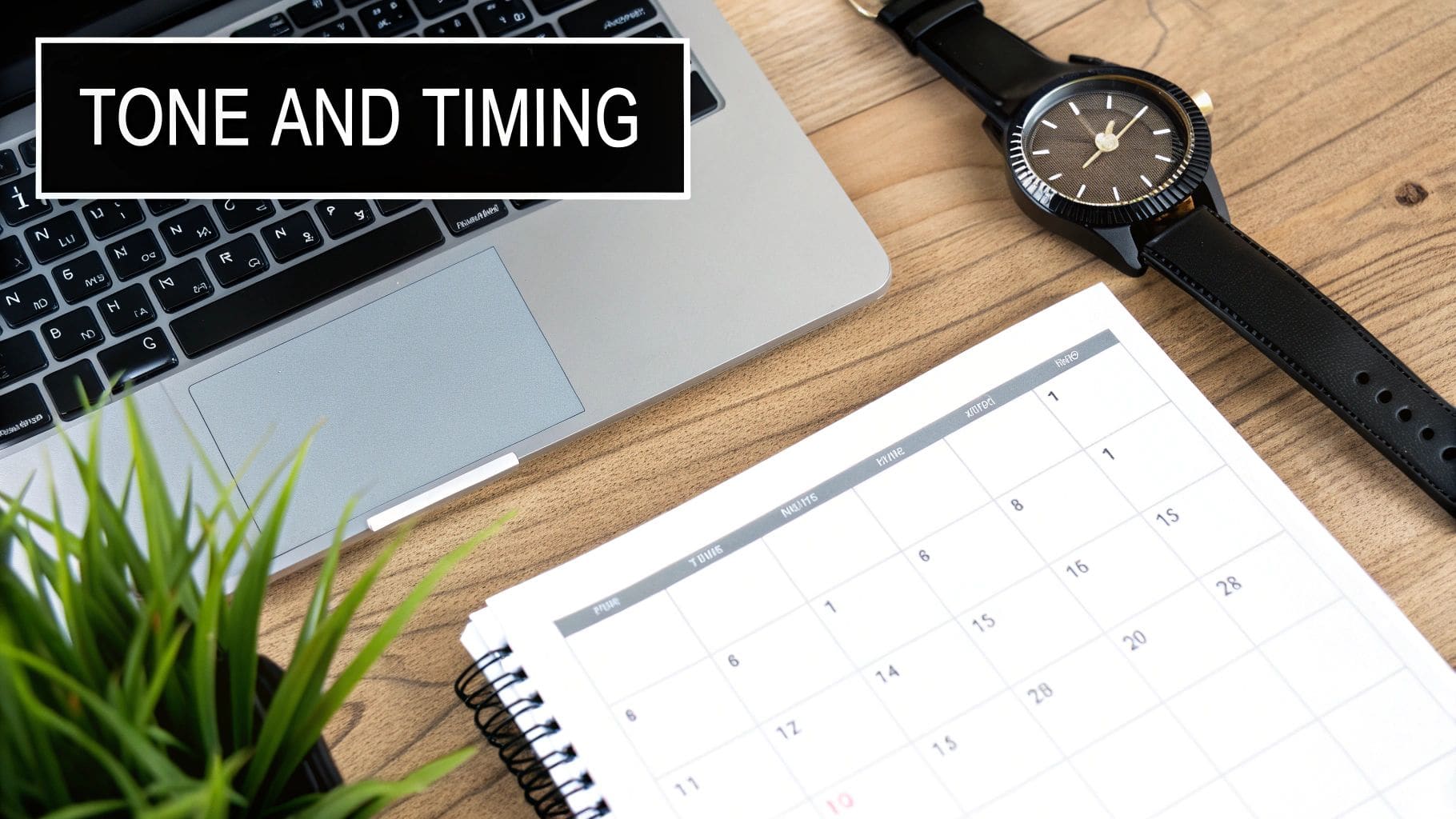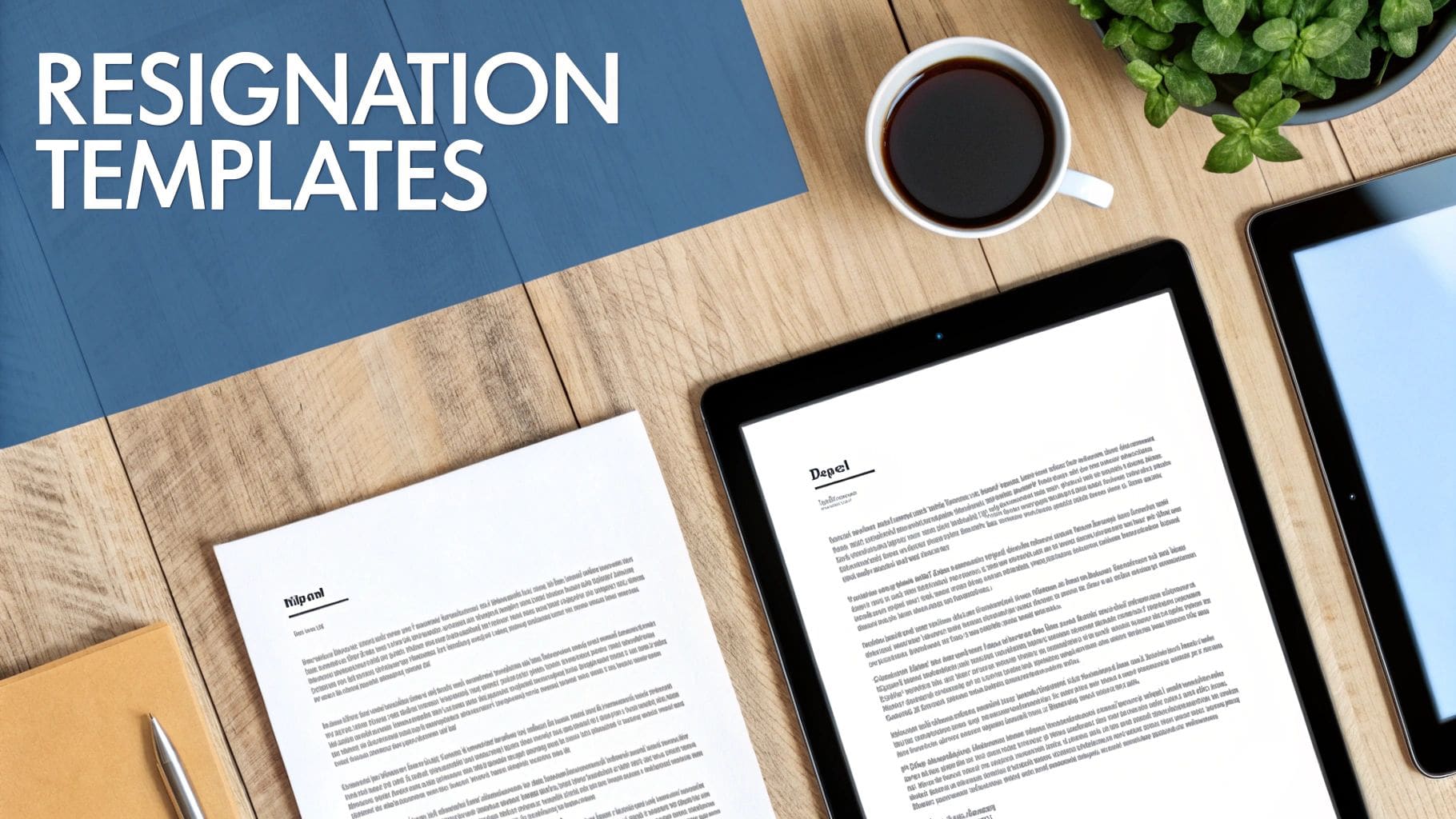How to Write a Professional Resignation Letter
Learn how to write a professional resignation letter with our expert guide. Get templates and practical tips for a smooth, confident career transition.

How to Write a Professional Resignation Letter
A professional resignation letter is the official document that begins your departure from a job, serving as your final professional handshake. Its primary purpose is to clearly state your last day of employment and offer assistance to ensure a smooth transition. This simple act helps you leave on good terms, preserving valuable professional relationships for the future.
The Key Elements of a Resignation Letter

When it's time to move on, your resignation letter is the final piece of the puzzle. It's more than just a piece of paper; it's a strategic tool that helps you protect your professional reputation and keep valuable connections intact. Getting it right is non-negotiable.
The whole point of this document is to be crystal clear. There should be zero room for misinterpretation. To achieve that, every solid resignation letter is built on three essential pillars.
The Three Core Components
First, you need a direct statement of your resignation. This should be a straightforward, unambiguous sentence right at the beginning. Something like, "Please accept this letter as my formal notification that I am resigning from my position as [Your Job Title] at [Company Name]."
Next up is your final day of employment. Providing a specific date removes any guesswork and gives your manager and HR the timeline they need to start the offboarding process. The standard "My last day will be [Your Last Day]" works perfectly.
Finally, a genuine offer to help with the transition is a must. This shows you're committed to the company's well-being, even as you're heading out the door. A simple, "I am happy to help train my replacement and ensure a smooth handover of my responsibilities," shows a ton of goodwill and professionalism.
Your resignation letter is your last chance to make a great impression. Keep it concise, professional, and forward-looking. Focus on a smooth transition, not airing old grievances.
To make things even clearer, here's a quick rundown of what you absolutely should and shouldn't do when writing your letter.
Resignation Letter Dos and Don'ts
This table is your cheat sheet for crafting a professional letter that leaves the right impression. Sticking to these guidelines helps you avoid common pitfalls that can burn bridges.
| Do | Don't |
|---|---|
| Be direct and concise. State your intention to resign clearly in the first paragraph. | Vent or complain. The letter is not the place to air grievances about your manager or the company. |
| Provide a specific end date. Offer at least the standard two weeks' notice, or more if your contract requires it. | Be vague about your last day. Avoid phrases like "in a couple of weeks" that can cause confusion. |
| Maintain a positive tone. Express gratitude for the opportunity and the experience you gained. | Share details about your new job. It's unnecessary and can come across as boastful or unprofessional. |
| Offer to help with the transition. This shows professionalism and a commitment to a smooth handover. | Make promises you can't keep. Only offer assistance that you are genuinely willing and able to provide. |
Following these simple rules ensures your departure is handled professionally, helping you maintain your network and reputation for whatever comes next in your career.
Get your free CV review
Upload your CV and get instant AI suggestions to improve your chances
Structuring Your Letter for a Professional Exit

Think of your letter of resignation not as a simple note, but as the final official document that solidifies your professional reputation at a company. A well-structured letter is your blueprint for a graceful exit. It's all about guiding your manager through the essential information clearly and without any drama, ensuring the whole process is handled with professionalism.
The good news? It doesn't need to be complicated. In fact, simplicity and clarity are your best friends here. Let's break down the key parts you'll need to include.
The Formal Opening and Statement of Resignation
Kick things off with the business letter basics: the date, your manager's full name and title, and the company's name. This standard format immediately sets a professional tone.
Right after the greeting, get straight to the point. Your very first paragraph should clearly state your intention to resign. There's no need to beat around the bush. A simple, direct sentence like, "Please accept this letter as formal notification of my resignation from my position as [Your Job Title]" does the job perfectly. This direct approach is the hallmark of an effective resignation letter.
Specifying Your Last Day
Once you've stated your resignation, the next critical piece of information is your final day of employment. For your employer, this is arguably the most important detail in the entire letter, as it officially starts the clock on the transition and hiring process.
Be specific. Stating, "My final day of employment will be [Your Last Day]" is much clearer than a vague phrase like "in two weeks." It prevents any scheduling confusion or misunderstandings down the line and shows you respect your employer's need to plan.
Your resignation letter's job is to inform, not to explain. Save the detailed reasons for your departure for a one-on-one conversation with your manager. This formal document isn't the place for it.
Expressing Gratitude and Offering Support
Even though you're on your way out, it's a smart move to acknowledge the good parts of your time with the company. A short, sincere line expressing gratitude can go a long way in shaping how your departure is perceived. Something as simple as, "Thank you for the opportunity to have been a part of this team," is more than enough to leave on a positive note.
Next, show you're a team player right up to the end by offering to help with the transition. This proactive step shows you're a responsible professional committed to a smooth handover. You could include a line like:
- "I am committed to ensuring a smooth transition and am happy to assist in training my replacement."
- "Please let me know how I can help wrap up my duties over the next two weeks."
This collaborative tone helps maintain those positive professional relationships you've built. Crafting this kind of message uses similar skills to other professional communications, which you can see in our resources on writing effective cover letters.
The Professional Closing
Wrap it all up with a simple, professional closing. Phrases like "Sincerely," or "Best regards," followed by your typed name and signature, are the standard for a reason—they work.
This clean ending reinforces the respectful and professional tone of your entire letter. By focusing on these distinct structural elements, you'll draft a document that is clear, courteous, and leaves a lasting positive impression.
Mastering the Tone and Timing of Your Resignation

How and when you resign can be just as important as what your resignation letter actually says. The tone you strike in that final conversation sets the stage for your last few weeks and ultimately shapes how you're remembered long after you're gone.
Even if you're leaving a frustrating situation, your formal letter is not the place to air grievances. Keep it positive, appreciative, and focused on the future. A simple "thank you for the opportunity" goes a long way in protecting your professional reputation and keeping your network strong.
After all, people leave for all sorts of reasons. A recent survey found that whilst 38% of workers left for better pay, many others were driven by a need for change (26%) or poor work-life balance (23%). Whatever your reason, grace is the goal.
Choosing the Right Moment
Timing is everything. Whilst there's no single "perfect" day to quit your job, some moments are definitely better than others. Dropping the news on a Monday morning often means your manager is already swamped with the week's priorities. A late Friday announcement can feel rushed and dismissive.
I've found that mid-week—a Tuesday or Wednesday—often hits the sweet spot. It gives everyone enough time to process the news and start sketching out a transition plan before the week is over. But the most critical part of timing isn't the day of the week. It's who you tell first.
Always speak with your direct manager in person or via video call before sending your formal resignation letter. This is a non-negotiable sign of respect that prevents them from being blindsided and allows for a real conversation.
The In-Person Conversation
Scheduling a private meeting to deliver the news is a must. This conversation allows you to control the narrative, show respect, and express your appreciation directly, rather than through a cold email.
When you sit down with your manager, keep your message consistent with what your letter will say. It should be short, professional, and to the point:
- State your intention to resign clearly.
- Provide your proposed last day of employment.
- Briefly express gratitude for the experience.
- Reiterate your commitment to ensuring a smooth handover.
This personal touch reinforces the positive tone of your formal letter and helps kick off your exit on the right foot. It's a small step that makes a huge difference in managing the process gracefully.
Just as a strong letter solidifies your departure, a well-written cover letter is key to securing your next role. You can learn more by checking out our real-world cover letter examples. You should also be aware of any legal expectations around your departure; for example, understanding your notice rights in Ontario can ensure a smooth transition.
Resignation Letter Examples for Any Situation

Knowing the theory is one thing, but seeing it in action makes all the difference. To help you get this done quickly and professionally, I've put together a few ready-to-use examples for common situations you're likely to face.
These templates are designed to be clear, respectful, and easy to tweak for your specific circumstances.
Let's face it, a lot of people are writing these letters these days. The "Great Resignation" wasn't just a headline; it was a massive shift. The U.S. Bureau of Labor Statistics reported that an astonishing 47 million Americans quit their jobs back in 2021. So, if you're feeling nervous, remember you're in good company.
The Standard Formal Letter
This is your go-to for most corporate or formal workplaces. It's direct, professional, and hits all the necessary points without any fluff. If you're ever unsure which tone to strike, this is your safest and most reliable option.
[Your Name]
[Your Address]
[Your Phone Number]
[Your Email]
[Date]
[Manager's Name]
[Manager's Title]
[Company Name]
[Company Address]
Dear [Manager's Name],
Please accept this letter as formal notification that I am resigning from my position as [Your Job Title] at [Company Name]. My last day of employment will be [Your Last Day], two weeks from today's date.
Thank you for the opportunity to have worked here for the past [Number] years. I have greatly valued my time with the company and appreciate the skills I've gained.
I am committed to ensuring a smooth transition during my final two weeks. Please let me know how I can best assist with the handover of my responsibilities.
I wish you and the company all the best for the future.
Sincerely,
[Your Signature]
[Your Typed Name]
A Letter with Personal Gratitude
Sometimes, a purely formal letter doesn't feel right. If you've built a strong relationship with your manager or had a mentor who really made a difference, adding a personal touch is a great move. This approach lets you express genuine appreciation whilst keeping things professional.
Dear [Manager's Name],
Please accept this as my formal resignation from my role as [Your Job Title] at [Company Name], effective two weeks from today, [Date]. My final day will be [Your Last Day].
I want to express my sincere gratitude for your mentorship and guidance during my time here. I have learned so much under your leadership, and I am especially thankful for the opportunity to have worked on [Specific Project or Skill].
I am dedicated to making this transition as seamless as possible and will do everything I can to wrap up my duties and train my replacement. I look forward to staying in touch and wish you and the team continued success.
Best regards,
[Your Signature]
[Your Typed Name]
It's funny how one letter marks an ending whilst another marks a beginning. Just as these examples provide a clear structure for your exit, you'll find similarly useful templates in our guide covering real-world cover letter examples for when you start pursuing that next opportunity.
The Remote Position Resignation
Leaving a remote job follows the same core principles, but the logistics are a bit different. Your resignation letter needs to be just as formal and proactive, even if you won't be physically present in an office for your final weeks. The key is to signal your commitment to a smooth digital handover.
Dear [Manager's Name],
This letter is to formally notify you of my resignation from the position of [Your Job Title] at [Company Name]. My last day of work will be [Your Last Day].
I have truly enjoyed my time working remotely with the team and am grateful for the experience. I am committed to ensuring a smooth handover of all my projects and responsibilities. I am available to coordinate via video call to discuss a transition plan and will ensure all digital files are organised for my successor.
Thank you again for the opportunity. I wish everyone at [Company Name] the very best.
Sincerely,
[Your Typed Name]
Common Resignation Mistakes to Avoid
Handing in your resignation is a defining moment in your career, but it's surprisingly easy to get wrong. A simple misstep can tarnish an otherwise smooth departure. Knowing what not to do is just as critical as knowing what to include in your letter.
So many professionals stumble here, letting emotions get the best of them or just being careless with the details. Let's walk through the pitfalls I've seen trip people up time and time again.
Don't Let Emotions Run the Show
The biggest mistake? Getting overly emotional or negative. Your resignation letter is a permanent document, and any complaints—whether about your manager, the company culture, or your pay—can burn bridges and follow you for years. It's just not worth it.
Instead, commit to a professional and gracious tone, no matter why you're really leaving. Your final impression should be one of integrity.
Another common error is oversharing details about your new job. It's natural to be excited, but talking about your new company, title, or salary can come across as boastful or unprofessional. It's best to keep those details private.
Mind the Logistics of Your Exit
Beyond the letter's content, simple logistical errors can create a lot of unnecessary friction. Firing off your resignation through a text message or Slack DM is a huge red flag. It shows a lack of respect for your employer and the entire process.
Equally problematic is giving inadequate notice. Unless your contract says otherwise, two weeks' notice is the gold standard. Anything less leaves your team in a tough spot and reflects poorly on your sense of responsibility.
One thing people always forget to plan for is the counteroffer. Decide before you resign whether you would accept one. If your decision to leave is final, be ready to decline it politely but firmly. Sticking to your plan shows you're decisive and professional.
We're seeing a new wave of resignations sweep across industries as people re-evaluate their careers. A global survey from LinkedIn and Microsoft found that 46% of employees are considering leaving their jobs in the next year. This trend just highlights how important it is to manage your exit properly. You can discover more about this re-resignation trend and what it means for the modern workforce.
As you plan your next move, remember that your professional network is one of your most valuable assets. Now is the perfect time to make sure your online presence is polished, which is why you should learn how to optimise your LinkedIn profile to attract that next great opportunity.
By sidestepping these common mistakes in your exit strategy, you can guarantee a smooth departure that keeps your professional reputation intact.
Got Questions About Resigning? We've Got Answers.
Even with the perfect template in hand, putting in your notice can feel… weird. It's a high-stakes, personal moment, and it's completely normal to have a few last-minute questions buzzing around your head. Let's clear up some of the most common uncertainties so you can handle this final step with total confidence.
From what to include (and what to leave out) to navigating a tricky notice period, here's what you need to know.
Should I Explain Why I'm Leaving in the Letter?
Honestly? No. You have zero obligation to detail your reasons for resigning in the letter itself. It's actually better to keep it short, sweet, and professional. The whole point of the letter is to formally notify your employer that you're leaving and to state your last day.
Going into a long explanation can open a can of worms you don't want to deal with. If you're on great terms and feel like sharing, the face-to-face chat with your manager is the right time and place for that conversation.
Think of your letter as an official HR document, because that's what it is. Stick to the essentials: your intent to resign, your role, and your final day. Anything else is just noise.
What if I Can't Give the Full Two Weeks' Notice?
Look, life happens. Whilst two weeks' notice is the gold standard in most fields, sometimes it's just not possible. If you find yourself in a tight spot and have to give less notice, you need to handle it with extra professionalism and care.
Acknowledge the short notice directly in your letter and express your regret for any disruption it might cause. More importantly, immediately offer to do everything in your power to make the handover as smooth and quick as possible. This proactive approach shows you still respect their position, even if your timing isn't ideal.
How Should I Actually Send the Letter?
The best way to do this is to have the conversation in person first, then immediately follow up with the formal letter. After you've spoken with your manager, you can either hand them a printed copy or, more commonly these days, email it directly to them and CC HR.
Here's the breakdown:
- The In-Person Talk: Don't skip this. It's a fundamental sign of respect.
- The Email Follow-Up: Send the letter right after your meeting. This creates a clean digital trail with a timestamp.
- A Printed Copy: Offering a physical copy is a nice, formal touch but isn't strictly necessary in most modern workplaces.
Whatever you do, avoid quitting through informal channels like a text or a Slack message. It comes across as highly unprofessional.
Once your resignation is in and you're officially on the hunt for your next role, staying organised is everything. Tools like a job application tracker can be a lifesaver for keeping all your opportunities in one place.
Can My Employer Actually Refuse My Resignation?
In most at-will employment situations, nope. An employer can't "refuse" your resignation. You are notifying them of your departure, not asking for permission to leave. Once that letter is submitted, your decision is legally effective.
Now, what they can do is try to convince you to stay, maybe by throwing a counteroffer your way. It's smart to decide how you'll handle that scenario before you even walk into your manager's office. If you're set on leaving, you can politely but firmly decline and just reiterate your last day. Being clear prevents any confusion and ensures you make a clean, professional exit.
Ready to make your next career move with confidence? The CV Anywhere platform provides all the tools you need, from a smart CV builder to an interview coach. Stop juggling spreadsheets and start building a compelling professional story that gets you hired. Explore our plans and see how we can help you land your next great role at https://cvanywhere.com.
Tags
Related Articles
How to Write a Letter for Resignation Letter
How to Write a Letter for Resignation Letter Writing a professional letter for resignation letter is the final, crucial step in leaving your job. It's more than just a formality; it's the official doc...
Read more →Your Professional Letter of Resignation Letter Guide
Your Professional Letter of Resignation Letter Guide Crafting a professional letter of resignation letter is more than just an official notice—it's your last formal impression. This strategic document...
Read more →Resume Worded vs CV Anywhere: A Head-to-Head Analysis
Resume Worded vs CV Anywhere: A Head-to-Head Analysis Choosing between resume tools like Resume Worded and CV Anywhere boils down to your primary goal. This guide provides a direct comparison to help ...
Read more →Popular Articles
Finding the right cv template google docs can be a great starting point for your job search, but it's often not the most effective path to getting hired. Whilst templates offer a visual framework, the...
The best way to craft a comprehensive and professional CV of curriculum vitae is with a dedicated tool like CV Anywhere's CV builder. It ensures your document is perfectly formatted and optimised to h...
Stop searching for the perfect template of resume. Trawling through hundreds of options to find one that fits your experience is an outdated, frustrating process. The solution isn't a better template;...
Here is a detailed breakdown of the 12 best options for a resume maker for free available today. We've done the research for you, so you can stop searching and start building a professional, job-winni...
Picking the right resume templates is your first—and most important—move in getting a recruiter's attention. It's not just about looks; a great template is a strategic tool. It organizes your career s...